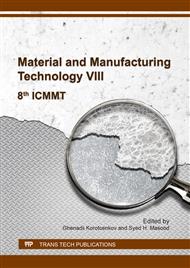[1]
S. Supriadi, T. W. Sitanggang, B. I. S., B. Suharno, G. Kiswanto, and T. Prasetyadi, Orthodontics Bracket Fabrication Using the Investment Casting Process, Int. J. Technol., vol. 4, no. October 2015, p.613–621, (2015).
DOI: 10.14716/ijtech.v6i4.1862
Google Scholar
[2]
S. Banerjee and C. J. Joens, Debinding and sintering of metal injection molding (MIM) components, Handb. Met. Inject. Molding, no. Mim, p.109–133e, (2012).
DOI: 10.1533/9780857096234.1.133
Google Scholar
[3]
X. quan LIU, Y. min LI, J. ling YUE, and F. hua LUO, Deformation behavior and strength evolution of MIM compacts during thermal debinding, Trans. Nonferrous Met. Soc. China (English Ed., vol. 18, no. 2, p.278–284, (2008).
DOI: 10.1016/s1003-6326(08)60049-7
Google Scholar
[4]
P. Pachauri and M. Hamiuddin, Optimization of Debinding Process Parameters in Metal Injection Molding ( MIM ) for High Density of Sintered Parts, vol. 2, no. 1, p.12–22, (2016).
Google Scholar
[5]
I. Mutlu and E. Oktay, Influence of Fluoride Content of Artificial Saliva on Metal Release from 17-4 PH Stainless Steel Foam for Dental Implant Applications, J. Mater. Sci. Technol., vol. 29, no. 6, p.582–588, (2013).
DOI: 10.1016/j.jmst.2013.03.006
Google Scholar
[6]
M. I. H. Chua, A. B. Sulong, M. F. Abdullah, and N. Muhamad, Optimization of Injection Molding and Solvent Debinding Parameters of Stainless Steel Powder ( SS316L ) Based Feedstock for Metal Injection Molding, vol. 42, no. 12, p.1743–1750, (2013).
DOI: 10.4028/www.scientific.net/kem.471-472.558
Google Scholar
[7]
Y. Li, S. Liu, X. Qu, and B. Huang, Thermal debinding processing of 316L stainless steel powder injection molding compacts, J. Mater. Process. Technol., vol. 137, no. 1–3 SPEC, p.65–69, (2003).
DOI: 10.1016/s0924-0136(02)01067-1
Google Scholar
[8]
M. Porter, Effects of Binder Systems for Metal Injection Moulding, (2003).
Google Scholar
[9]
S. T. Lin and T. Lin, Interface Controlled Decarburisation Model for Injection Moulded Parts During Debinding Technical note Interface controlled decarburisation model for injection moulded parts during debinding, vol. 5899, no. March, (1997).
DOI: 10.1179/pom.1997.40.1.66
Google Scholar
[10]
L. Liu, N. H. Loh, B. Y. Tay, S. B. Tor, Y. Murakoshi, and R. Maeda, Effects of thermal debinding on surface roughness in micro powder injection molding, vol. 61, p.809–812, (2007).
DOI: 10.1016/j.matlet.2006.05.070
Google Scholar
[11]
S. Supriadi and E. Baek, Sintering of Stainless Steel Nanopowders for Micro-component Part Applications, vol. 493, p.697–702, (2014).
DOI: 10.4028/www.scientific.net/amm.493.697
Google Scholar
[12]
A. Páez-pavón, A. Jiménez-morales, T. G. Santos, L. Quintino, and J. M. Torralba, Influence of thermal debinding on the fi nal properties of Fe – Si soft magnetic alloys for metal injection molding ( MIM ), J. Magn. Magn. Mater., vol. 416, p.342–347, (2016).
DOI: 10.1016/j.jmmm.2016.05.031
Google Scholar
[13]
S. Ani, A. Muchtar, N. Muhamad, and J. A. Ghani, Binder removal via a two-stage debinding process for ceramic injection molding parts, Ceram. Int., vol. 40, no. 2, p.2819–2824, (2014).
DOI: 10.1016/j.ceramint.2013.10.032
Google Scholar


